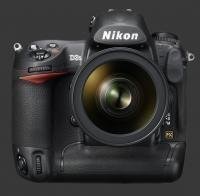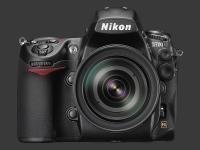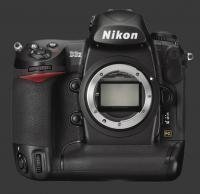Nikon D3X Review
Nikon D3X Performance - How well does it take pictures?
Ultimately, image quality makes a camera worth buying. For a digital SLR, image quality greatly depends on the lens used. While noise, color, exposure and dynamic range are properties of the camera, distortion, vignetting and chromatic aberrations are properties of the lens. Sharpness depends on the weakest link. So, the camera cannot capture more details than the lens lets through. Conversely, a good lens can transmit more details than the sensor can capture.
 The aging flagship DSLR from Nikon has yet to be beaten. After 3 years of technological advancements, no current DSLR produces the quality of images seen by the Nikon D3X in terms of resolving details. The 25 megapixels CMOS sensor used in this digital SLR produces extremely clean images with impeccably sharp details at ISO 50 to 400. These images can be used for large prints up to 16"x24" which stand close-up scrutiny. The ISO 800 setting is almost as perfect.
The aging flagship DSLR from Nikon has yet to be beaten. After 3 years of technological advancements, no current DSLR produces the quality of images seen by the Nikon D3X in terms of resolving details. The 25 megapixels CMOS sensor used in this digital SLR produces extremely clean images with impeccably sharp details at ISO 50 to 400. These images can be used for large prints up to 16"x24" which stand close-up scrutiny. The ISO 800 setting is almost as perfect.
Image noise starts being visible at ISO 1600 where maximum print sizes get slightly reduced. Keep in mind, this is reduced from a moderately large size to something still relatively large like a 12"x18" which would show very fine-grained noise in mostly uniform areas. The expanded ISO 3200 and 6400 settings makes for nice but slightly noisy mid-size prints.
This camera delivers an excellent dynamic range, very close to the latest DSLRs, while capturing an amazing amount of nuances in terms of color and tonality. Only 2 DSLRs offer better high ISO performance due to their much larger pixels, the 12 megapixels D3S
Nikon D3S and D700
Nikon D700.
Colors from the Nikon D3X can be very accurate, although default settings are slightly off. Reducing saturation and brightness by one step provided the most accurate results with Picture Control set to Standard. The default Sharpness setting is a little soft, increasing by one delivers crisper results. Higher settings make sharpening artifacts appear quickly.
Automatic while-balance is good but requires some work, particularly under artificial light. This is probably the only area where the D3X shows its age as modern cameras have greatly improved in this area. Still, this DSLR has plenty of controls over white-balance, including a custom options which works perfectly well.
Nikon's high-end Matrix metering is probably the most reliable system. Without being perfect, it performs very well, rarely missing the ideal exposure by much. Some positive compensation is required to optimize details in low contrast scenes but those are never improperly exposed. It occasionally over-exposes scenes with small but very bright highlights, usually by 1/2 or 1 EV which is better than most metering systems.


The Nikon D3X is a very fast camera. Its speed is even more impressive considering the bandwidth required to output 14-bit RAW of 25 megapixels at 5 FPS which it can sustain for 34 frames. JPEG images which are 8-bit per pixels - as always - require less space and 70 of them can be captured in a single burst without loss of speed.
This DSLR rarely makes the photographer wait. It turns on and off instantly. The shutter is released immediately with an extremely short black out time. Shot-to-shot speeds are an incredible ¼s. The 51-point autofocus is very fast and accurate. It locks in under ¼s under a broad array of conditions, even in moderately low light. Focusing may take longer in very low light and with slow lenses. This is usually the case when shooting with a variable zoom lens at the telephoto end where they often cannot open more than F/5.6 or F/6.3. Still, it rarely takes more than ½s to lock focus.
Entering and exiting Playback mode is very quick and so is scrolling between images. The only relatively slow operation is zooming into images. When that happens, the camera shows an hourglass icon for less than 1 second while it reads the full-resolution image.
 The optical viewfinder is large and bright and makes it easy to determine what is in focus. It provides 100% coverage as one would expect of any high-end DSLR. There is a viewfinder shutter, activated by a small switch on the prism housing, which serves to block stray light from entering. This is mostly useful when shooting very long exposures. A diopter correction nob for those who wear prescription glasses is found on the side of the housing. The optical viewfinder slightly protrudes from the rear of the camera for extra comfort.
The optical viewfinder is large and bright and makes it easy to determine what is in focus. It provides 100% coverage as one would expect of any high-end DSLR. There is a viewfinder shutter, activated by a small switch on the prism housing, which serves to block stray light from entering. This is mostly useful when shooting very long exposures. A diopter correction nob for those who wear prescription glasses is found on the side of the housing. The optical viewfinder slightly protrudes from the rear of the camera for extra comfort.
There is a Live-View mode which is selected as a Drive Mode. This is one of the earliest Live-View and is limited in functionality. It is not exposure-priority in any mode but it previews white-balance. Contrast detect autofocus is available in Live-View but is extremely slow, taking easily in the order of 3-5s to lock.
With an enormous 2500 mAh battery and no built-in flash, it is still surprising to know that battery life is 4400 shots per charge, the highest of any digital camera. This is enough for any day and even weeks of shooting for some photographers.


Nikon D3X Conclusion
The Nikon D3X maintains its position among top quality DSLR even 3 years after its introduction. It delivers the highest resolution images among DSLRs while performing very throughout its ISO sensitivity range. Color with tweaking, metering, dynamic range and sharpness with a good lens are all exceptional. White-balance is good but not perfect but easily fixed using custom white-balance or presets.
The value of the D3X lies in its high-resolution capture, particularly between ISO 100 and 400, which is highly suitable for large prints. There is one camera to consider against the D3X and that is its sister model, the Nikon D3S
Nikon D3S. While externally identical, the D3S has half the resolution which permits it to reach much higher ISOs, up to 102400, and faster frame rates, up to 9 FPS, making it an ideal choice for available light and action shots. This leaves the D3X superior for landscape, architecture, studio and other situations which do not require such astronomical ISO sensitivities.
Handling is very good with external controls for all important functions and a highly customizable behavior. The Nikon D3X is fast and responsive and is unlikely to make the photographer miss a shot. Its 5 FPS continuous drive is fast with a good buffer. The only noteworthy issues some may have with this DSLR are its bulk and its premium price. Yet, for such a splendid performance, many photographers find it worth it.
 |
Please Support Neocamera
All information on Neocamera is provided free of charge yet running this website is a huge endeavor. Purchases made via affiliate links found throughout the site help keep it running and up-to-date. There is no additional cost to you, so please consider buying via these links to our affilates:
If you found any information on this site valuable and did not purchase via our affiliate links, please considering donating via PayPal:
Any amount will be greatly appreaciated. Thank you for your support!
Nikon D3X Highlights

Sensor-Size: 36 x 24mm

Actual size when viewed at 100 DPI
| 25 Megapixels DSLR | ISO 50-6400 |
| Nikon F Mount 1X FLM | Shutter 1/8000-30s |
| 100% Coverage Extra Large Viewfinder | Full manual controls, including Manual Focus |
| 1 Axis Digital Level | Custom white-balance with 2 axis fine-tuning |
| Weatherproof | Spot-Metering |
| 5 FPS Drive, 70 Images | Hot-Shoe & Sync-Port |
| 3" LCD 920K Pixels | Lithium-Ion Battery |
| Compact Flash x 2 |
Updates
2024.11.18

Best 2024 Photography Gifts for Every Budget
Great gifts for photographers and photo enthusiasts selected for every budget among the best products of 2024.
2024.08.07

Eye Protection Tips for Professional Photographers
The four main considerations for professional photographers regarding eyewear.
2024.07.14

Fujifilm X100VI Review
Flagship fixed-lens compact digital camera with a 40 MP sensor and Image-Stabilization, a first for the series. Retro design featuring dual control-dials, plus direct ISO, Shutter-Speed and EC dials. Its hybrid viewfinder can switch between EVF and OVF mode.
2024.05.09

Fujifilm GFX100 II Review
Flagship 102 Megapixels Medium-Format Mirrorless Digital Camera with 8-Stop 5-Axis IBIS, 8 FPS Drive, 8K Video and 400 MP Super-Resolution capture in a weatherproof and freezeproof body with dual control-dials and dual memory-card slots.
2024.04.03

Fujifilm X-T5 Review
Newest Fujifilm flagship boasting a 40 MP APS-C sensor, 5-axis IBIS with 7-stop efficiency, 15 FPS continuous drive, 6.2K Video capture, dual control-dials and dual SDXC UHS-II slots in a sturdy weatherproof and freezeproof body.
2023.11.20

Best Digital Cameras of 2023
Find out which are the Best Digital Cameras of 2023. All the new Mirrorless Digital Cameras from entry-level to high-end professional.
2023.07.10

Fujifilm X-H2 Review
40 Megapixels APS-C Hybrid Mirrorless Digital Camera with 7-stop IBIS. Fastest shutter ever and 8K video capture. Large builtin EVF with 0.8X magnification and 5.8 MP, plus an Eye-Start Sensor. Packed with features and large number of controls in a weatherproof and freezeproof body.
2023.05.07

Sony FE 20-70mm F/4G Review
Review of the unique Sony FE 20-70mm F/4G lens. The optical zoom of this lens spans ultra-wide-angle and medium focal-length coverage, making it one of the most versatile Full-Frame lenses on the market.
2023.01.15

Huion Inspiroy Dial 2 Review
Review of the Huion Inspiroy Dial 2 tablet, a medium sized drawing surface with dual dials and customizable buttons. Connects via USB-C or Bluetooth 5.0 with Windows, Linux and Android support.
2022.12.08

How to Pack for a Photo Trip
Find out how to pack for a travel photography trip, carry your gear safely while meeting airline regulations.
2022.11.13

Best Digital Cameras of 2022
The best digital cameras of 2022. A short list of the most outstanding models in their respective categories. Choose one for yourself or as a gift.
2022.09.21

Pentax DA* 60-250mm F/4 SDM Review
Review of the Pentax DA* 60-250mm F/4 SDM, the constant-aperture telephoto zoom with the highest zoom-ratio on the market.











